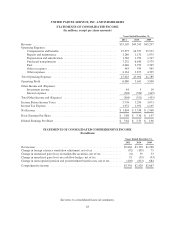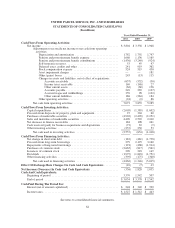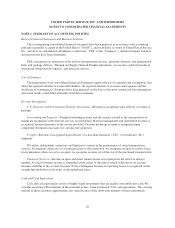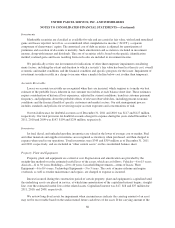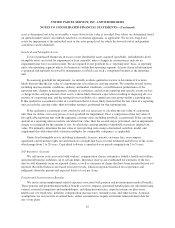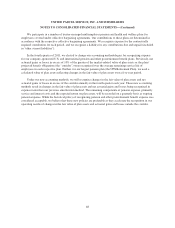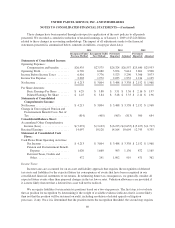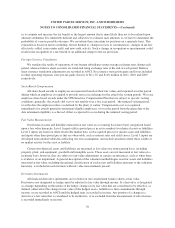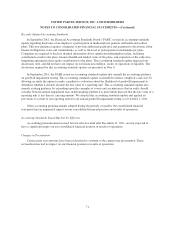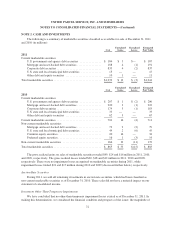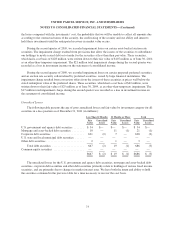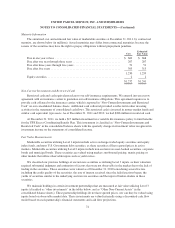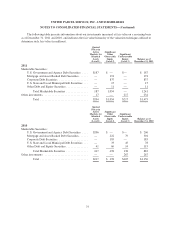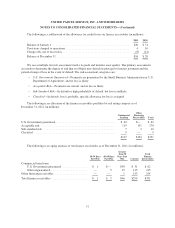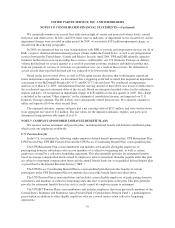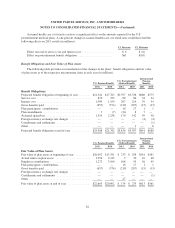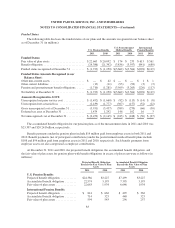UPS 2011 Annual Report Download - page 85
Download and view the complete annual report
Please find page 85 of the 2011 UPS annual report below. You can navigate through the pages in the report by either clicking on the pages listed below, or by using the keyword search tool below to find specific information within the annual report.
UNITED PARCEL SERVICE, INC. AND SUBSIDIARIES
NOTES TO CONSOLIDATED FINANCIAL STATEMENTS—(Continued)
the losses compared with the investments’ cost, the probability that we will be unable to collect all amounts due
according to the contractual terms of the security, the credit rating of the security and our ability and intent to
hold these investments until the anticipated recovery in market value occurs.
During the second quarter of 2010, we recorded impairment losses on certain asset-backed auction rate
securities. The impairment charge resulted from provisions that allow the issuers of the securities to subordinate
our holdings to newly issued debt or to tender for the securities at less than their par value. These securities,
which had a cost basis of $128 million, were written down to their fair value of $107 million as of June 30, 2010,
as an other-than-temporary impairment. The $21 million total impairment charge during the second quarter was
recorded as a loss in investment income on the statement of consolidated income.
During the second quarter of 2009, we recorded impairment losses on certain perpetual preferred securities,
and an auction rate security collateralized by preferred securities, issued by large financial institutions. The
impairment charge resulted from conversion offers from the issuers of these securities at prices well below the
stated redemption value of the preferred shares. These securities, which had a cost basis of $42 million, were
written down to their fair value of $25 million as of June 30, 2009, as an other-than-temporary impairment. The
$17 million total impairment charge during the second quarter was recorded as a loss in investment income on
the statement of consolidated income.
Unrealized Losses
The following table presents the age of gross unrealized losses and fair value by investment category for all
securities in a loss position as of December 31, 2011 (in millions):
Less Than 12 Months 12 Months or More Total
Fair
Value
Unrealized
Losses
Fair
Value
Unrealized
Losses
Fair
Value
Unrealized
Losses
U.S. government and agency debt securities ....... $ 34 $— $— $— $ 34 $—
Mortgage and asset-backed debt securities ........ 10 — 11 (1) 21 (1)
Corporate debt securities ...................... 621 (2) 7 — 628 (2)
U.S. state and local municipal debt securities ...... — — ————
Other debt securities .......................... 2 — 1 — 3 —
Total debt securities ...................... 667 (2) 19 (1) 686 (3)
Common equity securities ..................... — — ————
$667 $ (2) $ 19 $ (1) $686 $ (3)
The unrealized losses for the U.S. government and agency debt securities, mortgage and asset-backed debt
securities, corporate debt securities and other debt securities primarily relate to holdings of various fixed income
securities, and are primarily due to changes in market interest rates. We have both the intent and ability to hold
the securities contained in the previous table for a time necessary to recover the cost basis.
73


